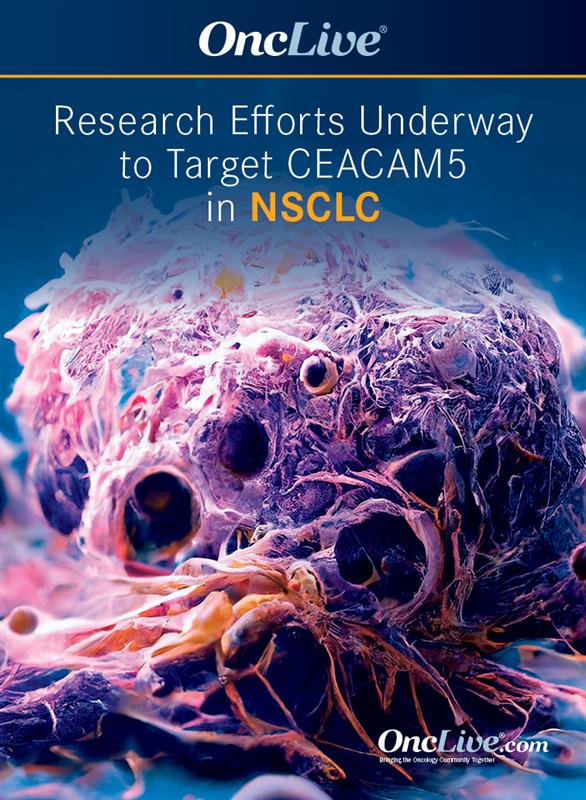Publication
Article
Supplements and Featured Publications
Anti-CEACAM5 ADC Could Represent the Next Targeted Therapy in Advanced Nonsquamous NSCLC
Author(s):
Alexander Spira, MD, PhD, FACP, discusses the rationale for targeting CEACAM5 in NSCLC, how tusamitamab ravtansine could provide encouraging frontline responses in the CEACAM5-positive, nonsquamous population, and enrollment challenges faced by ongoing clinical trials.
Alexander Spira, MD, PhD, FACP

Targeting CEACAM5 with the antibody-drug conjugate (ADC) tusamitamab ravtansine (SAR408701) may improve treatment outcomes in patients with CEACAM5-positive, nonsquamous non–small cell lung cancer (NSCLC), according to Alexander Spira, MD, PhD, FACP, who emphasized the importance of testing for the target through tissue-based assays.
The phase 2 CARMEN-LC05 trial (NCT04524689) is investigating the ADC tusamitamab ravtansine plus pembrolizumab (Keytruda) and tusamitamab ravtansine plus pembrolizumab and platinum-based chemotherapy with or without pemetrexed (Alimta) in patients with CEACAM5-positive, advanced or metastatic nonsquamous NSCLC.1 Additionally, tusamitamab ravtansine is being studied in the phase 3 CARMEN-LC03 (NCT04154956) and phase 2 CARMEN-LC06 (NCT05245071) trials, which are evaluating the agent vs docetaxel in previously treated patients with CEACAM5-positive nonsquamous NSCLC2 and as a single agent in patients with negative or moderate CEACAM5 expression and high circulating carcinoembryonic antigen (CEA),3 respectively.
“CEACAM5 is a cellular antigen,” Spira said. “We’ve known about it for a long time. It’s expressed on many cancers, [including] lung cancer cells.”
In an interview with OncLive®, Spira discussed the rationale for targeting CEACAM5 in NSCLC, how tusamitamab ravtansine could provide encouraging frontline responses in the CEACAM5-positive, nonsquamous population, and enrollment challenges faced by these ongoing clinical trials.
Spira is the codirector of the Virginia Cancer Specialists Research Institute and the Phase I Trial Program in Fairfax. He is also co-chair of the USOncology Thoracic Oncology Committee, chair of the USOncology Research Executive Committee, and a member of the USOncology National Policy Board Executive Committee. In addition, Spira is an assistant professor of oncology at Johns Hopkins School of Medicine in Baltimore, Maryland.
OncLive®: What makes CEACAM5 a novel target in lung cancer, and what is known about it?
Spira: We believe it’s an adhesion molecule. It’s somewhat related to CEA, which is [typically tested for and measured] in the blood, although [it serves a different purpose in the current lung cancer research]. It’s unique because as a cellular target, you can guide drugs to it, specifically ADCs.
Is CEACAM5 easily detectable and prevalent in lung cancer?
It’s detectable on the cancer cells; it’s unfortunately not yet detectable in blood. Assays that are detectable on tissue are always more complicated to do. However, it’s easily detected based upon known assays, usually an immunohistochemistry assay.
You’re a principal investigator on the CARMEN-LC05 trial. What is this trial’s importance in the current treatment landscape?
CARMEN-LC05 is a straightforward study. It’s looking to see if the use of an ADC, tusamitamab ravtansine, can improve outcomes in patients with [nonsquamous NSCLC]. We’ve seen some impressive single-agent activity with tusamitamab ravtansine. The idea now is to see how good we can get the responses to be in the frontline setting and see if we can improve outcomes in patients positive for CEACAM5.
Tusamitamab ravtansine is also being studied in the CARMEN-LC03 and CARMEN-LC06 trials. What are some anticipated challenges with enrollment to these trials?
The big challenge that we have with enrollment, especially in the frontline setting but in all settings as well, is that patients need to have a positive CEACAM5 test to enroll. This is always a challenge because we’re trying to get that test back while [balancing other tasks] and getting the patient on the study.
It would be great if we had a blood test instead because we wouldn’t [face issues such as] needing to wait for tissue or running out of tissue. This is something that, with hard work, should be surmountable, although it’s proving more challenging [than we initially thought], until CEACAM5 [testing is done routinely]. However, that usually happens once the drug is commercially available, rather than in clinical trials.
Pending positive data from these trials, do you see these tusamitamab ravtansine regimens replacing current chemoimmunotherapy combinations or being sequenced after them?
There are first-line and second-line studies currently ongoing. We always like to do more in the frontline setting, because that’s when patients are healthier and [have better] long-term outcomes. That would be the ideal, but any improvement is always good. Certainly, the second-line treatment for NSCLC needs much improvement as well.
Could co-mutations influence other potential combination strategies?
Although co-mutations are important, this target is relatively unique right now. We’ll be looking at [factors such as] PD-L1 status. However, co-mutations are probably less important for this mutation, as it’s unique when compared with others such as KRAS G12C, EGFR, and ALK.
What potential safety concerns can arise with ADCs like tusamitamab ravtansine?
ADCs have an antibody, a linker, and a warhead. As the warhead sometimes gets leaked into the blood because it doesn’t stay on perfectly well, [patients can have] cytopenias, nausea, and thrombocytopenia related to [their treatments]. [Additionally, we are] always worried about the gastrointestinal adverse effects, and many ADCs have some pulmonary toxicities. That all needs to be watched for in this patient population.
References
- Tusamitamab ravtansine (SAR408701) in combination with pembrolizumab and tusamitamab ravtansine (SAR408701) in combination with pembrolizumab and platinum-based chemotherapy with or without pemetrexed in patients with NSQ NSCLC (CARMEN-LC05) (CARMEN-LC05). ClinicalTrials.gov. Updated September 10, 2022. Accessed December 5, 2022. https://clinicaltrials.gov/ct2/show/NCT04524689
- SAR408701 versus docetaxel in previously treated, carcinoembryonic antigen-related cell adhesion molecule 5 (CEACAM5) positive metastatic non-squamous non-small cell lung cancer patients (CARMEN-LC03). ClinicalTrials.gov. Updated November 4, 2022. Accessed December 5, 2022. https://www.clinicaltrials.gov/ct2/show/NCT04154956
- Tusamitamab ravtansine in NSQ NSCLC participants with negative or moderate CEACAM5 expression tumors and high circulating CEA (CARMEN-LC06). ClinicalTrials.gov. Updated October 18, 2022. Accessed December 5, 2022. https://clinicaltrials.gov/ct2/show/NCT05245071







%20(2)%201-Recovered-Recovered-Recovered-Recovered-Recovered.jpg?fit=crop&auto=format)

%20(2)%201-Recovered-Recovered-Recovered-Recovered-Recovered.jpg?fit=crop&auto=format)
%20(2)%201-Recovered-Recovered-Recovered-Recovered-Recovered.jpg?fit=crop&auto=format)